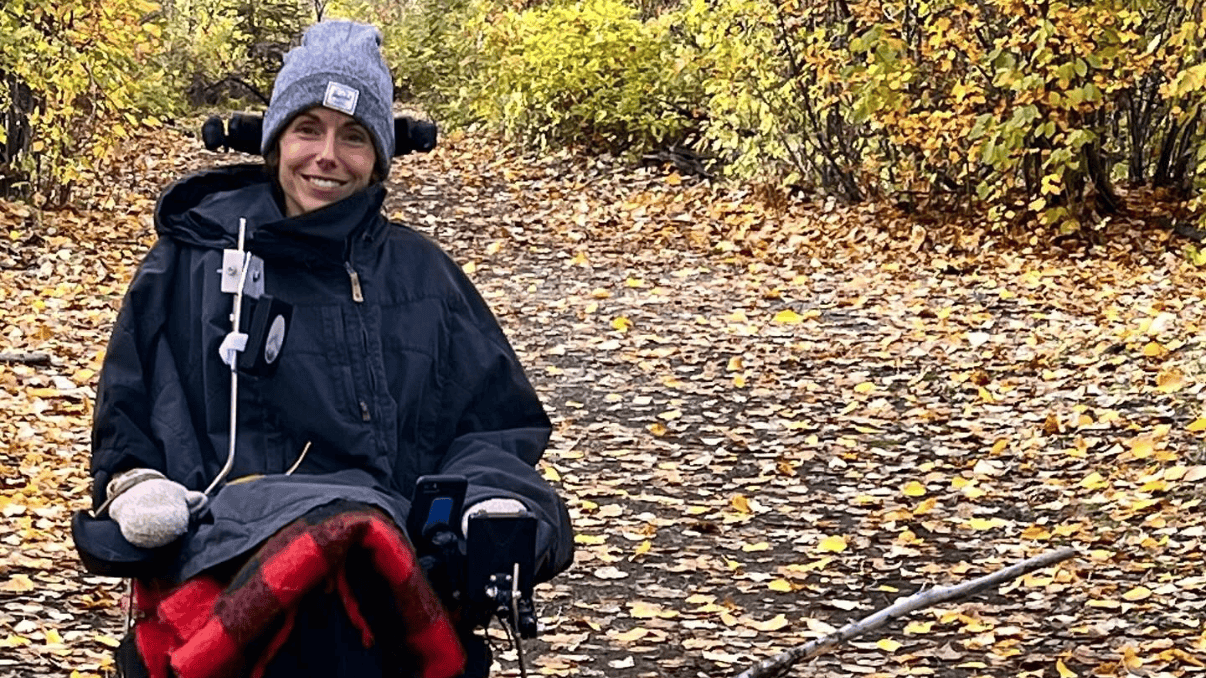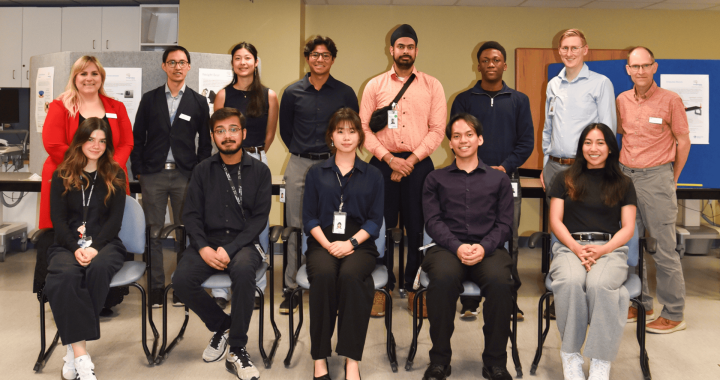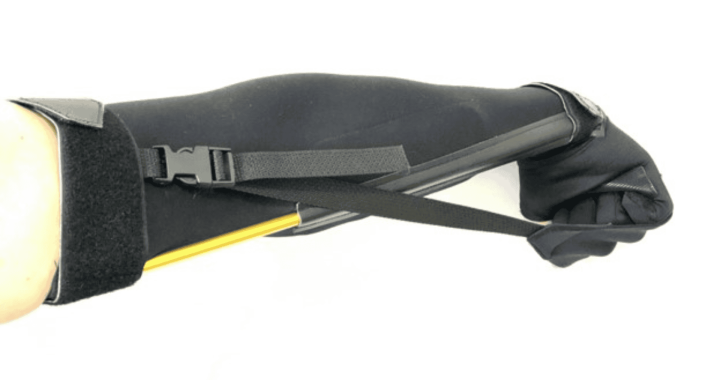When a mountain biking accident left her paralyzed, Chantelle never imagined she’d move again — until she discovered an exciting new spinal cord stimulation study at the Glenrose.
On June 15, 2019, Chantelle Grafton’s life changed when a mountain biking accident near her hometown of Prince George, B.C. left her with a severe spinal cord injury. While practicing a drop on the trail, she crashed, fracturing her C1, C2, and C3 vertebrae. Chantelle was paralyzed from the shoulders down.
For the next year, she relied on a ventilator to breathe.
“My goal was to get off the ventilator, and back to my life,” says Chantelle, who despite the odds, was back at her job in water management with the B.C. government just ten months after her injury.
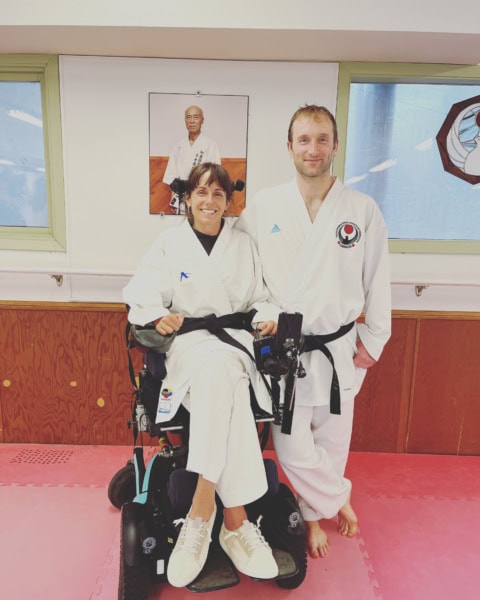 “I slowly began reclaiming the things I loved most: working, travelling, camping, and coaching karate with my husband,” she says. After her injury, she continued to do it all, just differently and with a little help along the way.
“I slowly began reclaiming the things I loved most: working, travelling, camping, and coaching karate with my husband,” she says. After her injury, she continued to do it all, just differently and with a little help along the way.
And her determination is what also shaped her into a passionate advocate for the spinal cord injury (SCI) community and research. In fact, that’s how she learned about a study being led by Dr. Jessica D’Amico at the Glenrose Rehabilitation Hospital.
Dr. D’Amico’s study explores Transcutaneous Spinal Simulation (TSS) — a non-invasive, over-the-skin stimulation of the spinal cord. The trial, which combines stimulation with traditional functional task practice or rehabilitation, explores its effects on restoring movement and function in SCI and stroke patients. Chantelle was thrilled to find this study happening so close to home.
“You expect to see research like this happening around the world, or if it’s anywhere in Canada, you expect it to be on the other side of the country. To see this level of research right here in Edmonton, it’s so exciting.”
When Chantelle started the trial in June 2025, she had very limited functional movement below her shoulders aside from some finger movement in her right hand and a small amount of flexion in her arm. But just two and a half weeks in, things began to change.
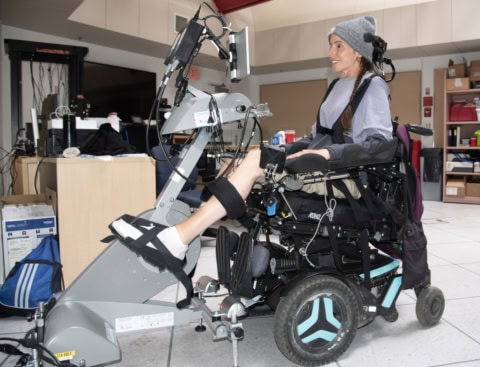 “There are muscles I didn’t know I had access to that I found,” she said. “It’s also really nice to do something physical again for the first time in six years. I was such an active person before my accident.” By the end of July, those small sparks of progress had grown into meaningful breakthroughs. Chantelle could curl her right arm three-quarters of the way, shake her hand, pinch, readjust her arm on her own, and even pet her dog.
“There are muscles I didn’t know I had access to that I found,” she said. “It’s also really nice to do something physical again for the first time in six years. I was such an active person before my accident.” By the end of July, those small sparks of progress had grown into meaningful breakthroughs. Chantelle could curl her right arm three-quarters of the way, shake her hand, pinch, readjust her arm on her own, and even pet her dog.
For her, these victories mean everything. “It’s given me enough of a foundation that I now think I can get towards lifting something up to my face, which for me means getting myself to eat or drink. From the trial I’m about 30% there, and that’s starting from nothing. Any less I need to ask for help is huge for feeling independent.”
The treatment itself is simple to describe but extraordinary in effect. During each session, electrodes placed on the back of her neck deliver a constant, vibration-like stimulation to her spinal cord while she works on exercises like gripping, pinching, and arm flexes. Over time, that stimulation reawakens pathways between her brain and spinal cord that had gone unused since her injury. “I know I may have this weak little muscle, but it’s there, and I now have access to it,” she says. “Before I just accepted that this is what I have, but now it’s changed that narrative; there’s so much unknown.”
For Dr. D’Amico, this trial represents a new era of hope. “For so long, people thought that once you had an injury and you were in the chronic phase, you needed to accept your limitations. What we’re seeing now with these novel solutions is that the nervous system can reshape itself and lead to improvements in quality of life for people who were previously told they may not see progress.”
The team’s ultimate goal is to expand the research into a multi-site trial across Canada and eventually create home-based therapies so that people like Chantelle can continue their rehabilitation independently. Chantelle, for one, is eager for that day. “That would be the dream, to be able to do this at home,” she says.
“I know for myself and I know for a lot of people, we’re more than happy to participate in things like this because in the long run it will improve our lives. I’m lucky that I can participate. It gives me purpose to give back to something that is going to benefit my community in the long run.”
For Chantelle, the Glenrose team has become more than researchers and therapists. “Everyone has been so nice, they’re my positive affirmation team,” she says. And for Dr. D’Amico and her colleagues, it’s people like Chantelle — open-minded, determined, and willing to give their all — that make progress like this possible. “None of the work we do would be possible without people like Chantelle.”
